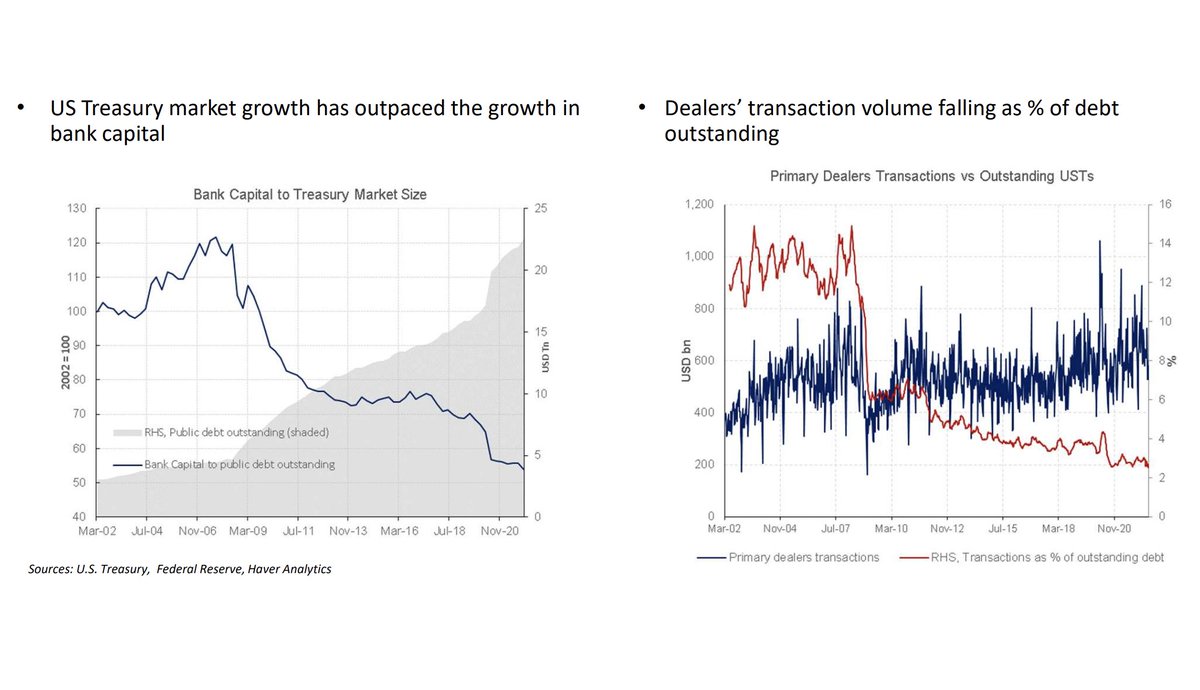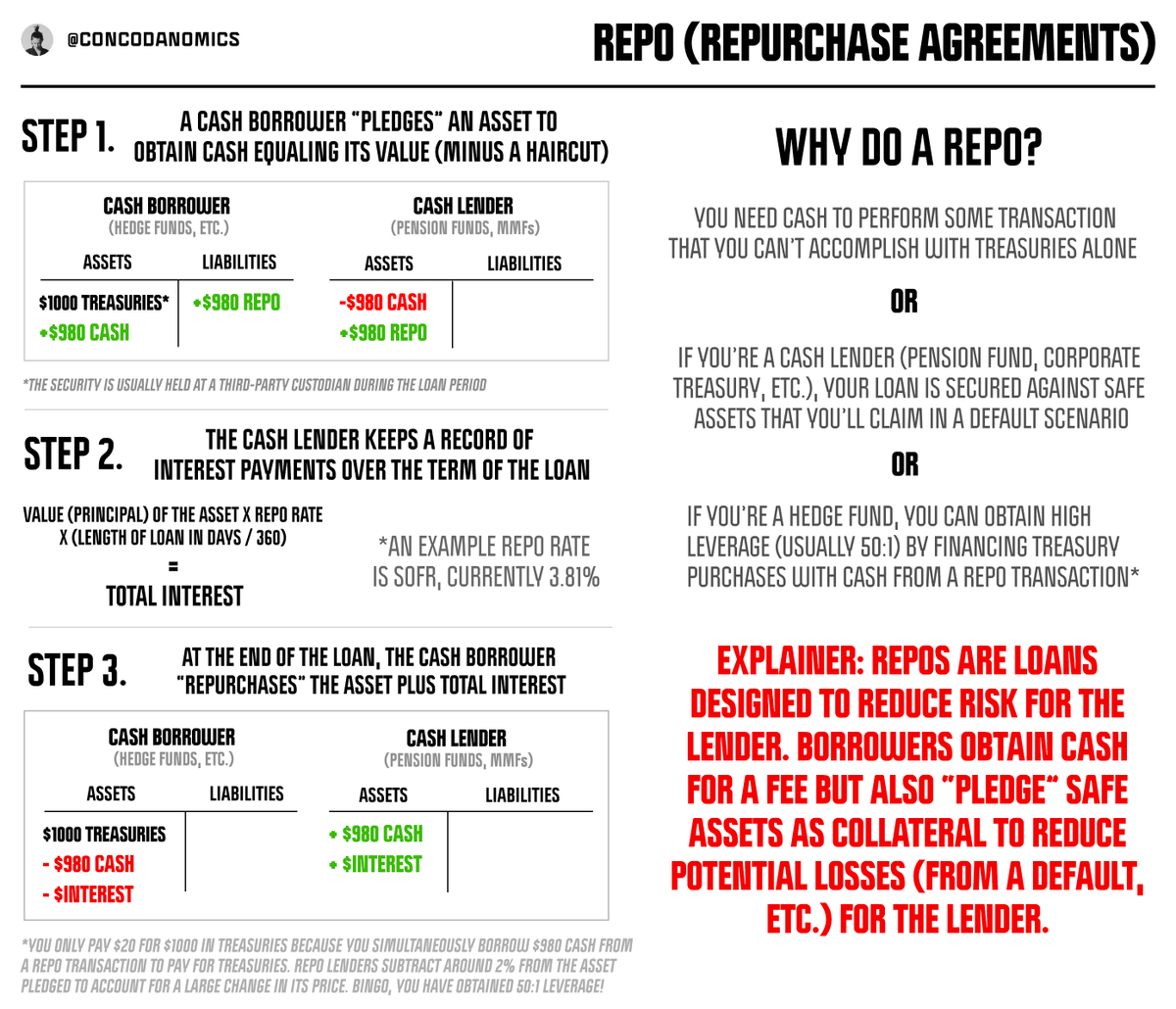The Great Sovereign Debt Intervention is here, with leaders now eager to prevent rising instability in America's bond market. Their tools, however, will not only prevent a calamity but stimulate risk assets without the aid of central banks. The "Treasury QE" era awaits us... 1/
After we warned last year about the growing dangers in the most systemically important market globally, America's sovereign bond market, monetary leaders have begun to react. The unintended consequences of past policies, regulations, and interventions can no longer be ignored...
https://twitter.com/concodanomics/status/1583269797785059329
Early this month, monetary leaders revealed their latest tool to paint over cracks in the U.S. empire’s liquidity goliath. Officials announced the first Treasury buyback program in over two decades, designed to thwart illiquidity in America’s $23 trillion sovereign debt market...
https://twitter.com/not_concoda/status/1661129953448976388
Over the last decade, the post-financial crisis regulatory establishment has forced the biggest liquidity providers in the Treasury market to retreat. The major players have pulled back from market-making, just as America embarks on its greatest debt binge in recent history...
Regulations such as Basel III and the Dodd-Frank Act have hindered major banks and dealers through balance sheet constraints, like the Supplementary Leverage Ratio (SLR) and Liquidity Coverage Ratio (LCR). The cost of making markets in Treasuries is ever-increasing... 

Meanwhile, to achieve its global and domestic aims, the U.S. empire is set to issue around $1 to $2 trillion of Treasury debt each year, all while the ability of financial actors to absorb such an amount is dwindling. Monetary leaders, however, have acknowledged the endgame...
The rules and restrictions they have enforced over the last decade have been designed to transfer systemic risk from big banks to the sovereign level. But to also keep the global liquidity machine churning, they will need to conjure up more monetary alchemy...
Though the details aren't set in stone, the U.S. Treasury will be conducting Treasury buybacks from 2024 and onwards. These have two objectives: to improve "cash management", jargon for reducing volatility in the Treasury's bank balance (seen below), and to boost liquidity...
https://twitter.com/not_concoda/status/1661829832735334439
Buybacks will also enable the Treasury to replace expensive bonds with those that cost less to service. What's more, much like the Federal Reserve, the Treasury will become a "dealer of last resort", acting as a buyer of illiquid bonds when no other participant is willing...
Using funds from either bond sales or its bank account at the Fed, the U.S. Treasury will purchase existing securities in the secondary market (via primary dealers such as JPMorgan and Nomura) to boost liquidity and even suppress yields. Lower yields mean cheaper expenses... 

Although Treasury buybacks give them the ability to greatly influence markets, officials have stated that the announced program won't be extensive enough to act as a bailout in times of stress. If turmoil emerges, other measures could be enacted...
https://twitter.com/concodanomics/status/1583269861022527494
Today, though, the number of tools officials can employ to quash volatility has grown more limited than ever before. The Fed can't initiate a full-blown pivot of rate cuts and QE without reigniting animal spirits, undoing all efforts to tackle inflation. Its toolbox is scarce...
Instead, officials at both the Fed and Treasury are doing everything in their power to continue a tightening cycle without reversing course. With a pivot off the table, they have been forced to implement what Conks calls the "Not-QE corridor", the new unconventional toolbox... 

Much like the Fed's "Global Jaws", which depicts the global dollar rates corridor, the "Not-QE corridor" has an upper and lower limit. When the upper boundary is reached, financial conditions have become too loose for the Fed to sit by idly. More rate hikes and QT will follow...
https://twitter.com/not_concoda/status/1651999000713736193
Conversely, when the lower limit is reached, financial conditions have tightened enough to warrant Fed intervention. The U.S. central bank, however, has no intention of pivoting until it's reached its 2% inflation target, so it must invent "stealth QE" facilities like the BTFP...
https://twitter.com/not_concoda/status/1659666051846512640
But while the Fed has been using all the easing and tightening tools available in its armory, the U.S. Treasury has yet to wield any. At the upper limit of the Not-QE corridor, the Treasury has chosen to avoid deploying "TQT": Tighter Quantitative Tightening...
With TQT, monetary leaders try to tighten conditions further by reducing the Fed's balance sheet at a faster pace while issuing more long-dated bonds to the market. The greater duration risk of longer-dated bonds causes investors to sell riskier assets to fund these purchases...
https://twitter.com/concodanomics/status/1629917769524473857
But at the lower limit of the Not-QE corridor, the Treasury does not currently possess any concrete tools to stimulate asset prices. After all, that's the job of the Federal Reserve. At the start of 2024, however, buybacks will commence, enabling the prospect of Treasury QE™...
https://twitter.com/not_concoda/status/1661108861816676368
If inflation remains higher for longer, and the Fed breaks something else not worth pivoting over, the Treasury can join forces with the Fed to help ease financial conditions. While the U.S. central bank creates more alchemy, the Treasury uses buybacks to juice risk assets...
Prior Treasury buyback programs have not been used by Treasury officials to specifically stimulate asset prices, but this time could be different. If politics at the Treasury and the Fed align during a period where a pivot is unwanted, the Fed's independence could be bypassed...
The first of two mechanisms they could use to stimulate financial assets via buybacks is simple: remove duration risk from the market by buying back longer-dated bonds and swapping them with shorter maturities. Swapping 30-year bonds for 2-year notes will be stimulative...
Still, to truly make this "quantitative easing for Treasuries", officials would have to announce that this is what they're doing in advance, thereby mimicking the psychological effects that traditional QE (buying bonds with newly printed bank reserves) has on riskier assets...
Then, there's the second "Treasury QE" mechanism, which this time boosts liquidity in the financial system and potentially increases risk-seeking behavior: Treasury buybacks where the newly issued bond is funded with cash drained from the Fed's RRP (reverse repo) facility...
https://twitter.com/not_concoda/status/1661108861816676368
Unlike the first kind of Treasury QE, easing occurs without Treasury officials ever intending to loosen financial conditions. If a money market fund (MMF) withdraws cash from the RRP, a Treasury buyback is all that's needed to boost risk-seeking potential. Liquidity increases...
https://twitter.com/not_concoda/status/1659152425171779584
Before this type of Treasury QE takes place, the MMF had originally invested in RRPs (reverse repo agreements) offered by the Fed. The result was a stable stream of overnight income for the MMF but a net draining of liquidity from the financial system...
RRPs are what Conks calls "reserve neutralizers". Reserves and bank deposits are "neutralized" .i.e temporarily removed from the banking system and replaced with the most illiquid cash-like investment: a reverse repo (RRP) issued by the Federal Reserve...
Unlike other short-term investments, cash is locked in the triparty repo platform, which the Fed uses to process RRP transactions, till 3:30pm the following evening. The price to pay for receiving free money from the Fed is "trapped" liquidity and often inferior returns...
When the MMF invests in an RRP, its commercial bank destroys the MMF's deposit and sends reserves to the Fed. Once received, the Fed transforms these reserves into an RRP liability on its balance sheet. Liquidity, in the form of bank deposits and reserves, has been neutralized...
https://twitter.com/not_concoda/status/1659181719986003968
But when the MMF decides to participate in a buyback by purchasing new bills the U.S. government is offering, this process "de-neutralizes" reserves and deposits, adding once-trapped RRP cash back into the banking system. Once again, liquidity has expanded...
This type of Treasury QE, however, can only be influential if MMFs are willing to unwind their RRP positions with the Fed and take part in upcoming buybacks. If investments other than RRPs, like bills and repo, offer superior returns, liquidity in the system will increase...
https://twitter.com/concodanomics/status/1654497048987566081
Ultimately, in both scenarios of Treasury QE, Treasury buybacks could be used as a QE-style signaling tool to further encourage investors to withdraw from money market funds (MMFs) and invest in riskier assets, thereby forcing more liquidity into the banking system...
Once implemented, monetary leaders will have fitted the missing piece in their Not-QE corridor. Treasury QE via buybacks and "stealth QE" from the Fed will provide a stronger lower bound to ease financial conditions when needed, while QT and TQT stand ready at the upper limit... 

What's more, if the Fed and Treasury have joint political goals, they can effectively bypass the Fed's so-called independence, coordinating the easing and tightening of financial conditions. They may also offset each other, with the Treasury "tightening" during Fed "easing"...
For now, monetary leaders only need to activate some elements of the Not-QE corridor. The U.S. Treasury has decided not to fire up TQT (Tighter Quantitative Tightening), while "Treasury QE" via buybacks only comes online as 2024 begins. Meanwhile, QT and "Not-QE" remain active...
QT (quantitative tightening) is still shrinking the Fed's balance sheet by $95 billion per month, whereas "Not-QE" (which some call "stealth QE") is delivering a somewhat stimulative effect to risk assets without the Fed ever printing reserves to buy bonds outright (real QE)...
Nobody, not even the Fed, seems to know what catalyst will cause officials to finally return to rate cuts, QE, or both. But if inflation remains sticky for longer than most expect, the Not-QE corridor won't collapse anytime soon, and monetary alchemy will prosper...
The Treasury market provides those who oversee it the power to control global finance like never before. Yet they've chosen not to use it to its full effect. But with Treasury QE on the way, those in charge may give in to temptation. These powers will eventually be activated...
It's widely believed that officials are running out of ideas and tools to preserve the system's stability. In reality, the golden age of intervention is still yet to come. When Treasury QE arrives, the Great Sovereign Debt Intervention™ will have only just begun.
Thanks for reading! If you enjoyed this, feel free to retweet the top tweet of this thread and follow @concodanomics for more.
You can also subscribe below to receive more in-depth articles about finance, markets, and geopolitics in your inbox...
👉 concoda.substack.com/subscribe 👈
You can also subscribe below to receive more in-depth articles about finance, markets, and geopolitics in your inbox...
👉 concoda.substack.com/subscribe 👈
• • •
Missing some Tweet in this thread? You can try to
force a refresh

 Read on Twitter
Read on Twitter





